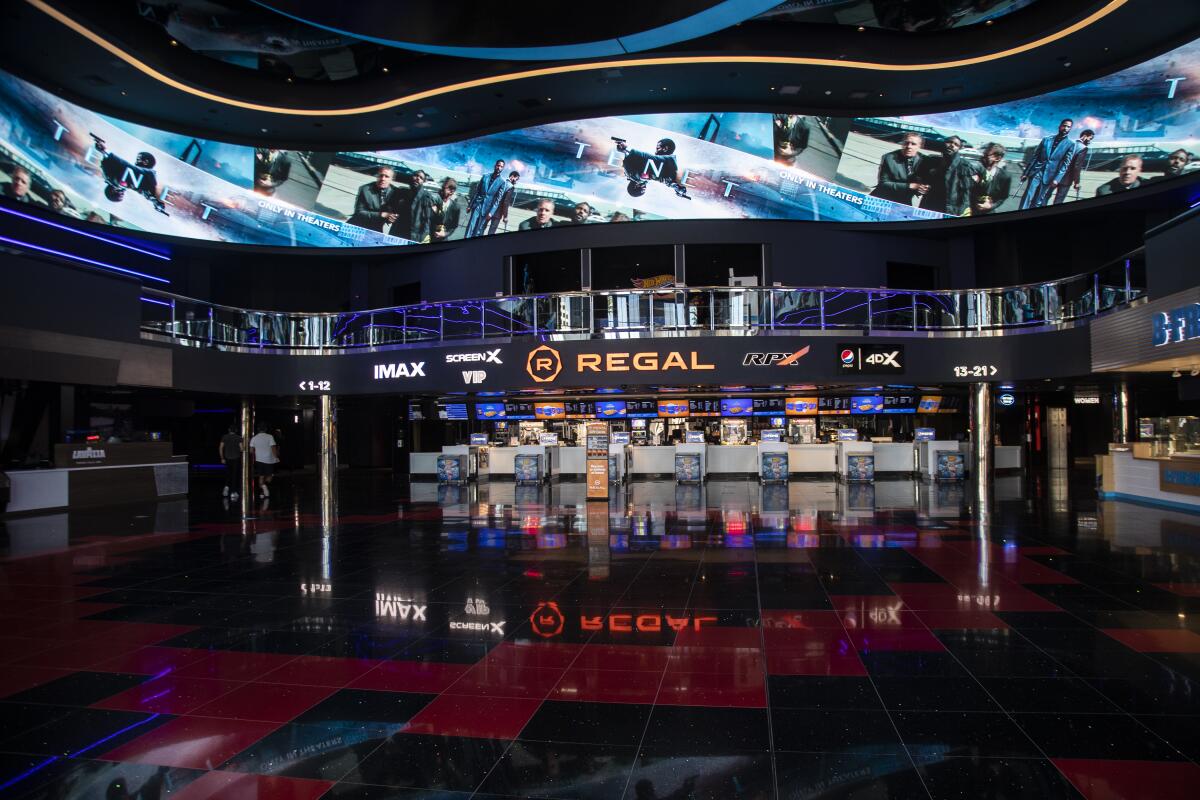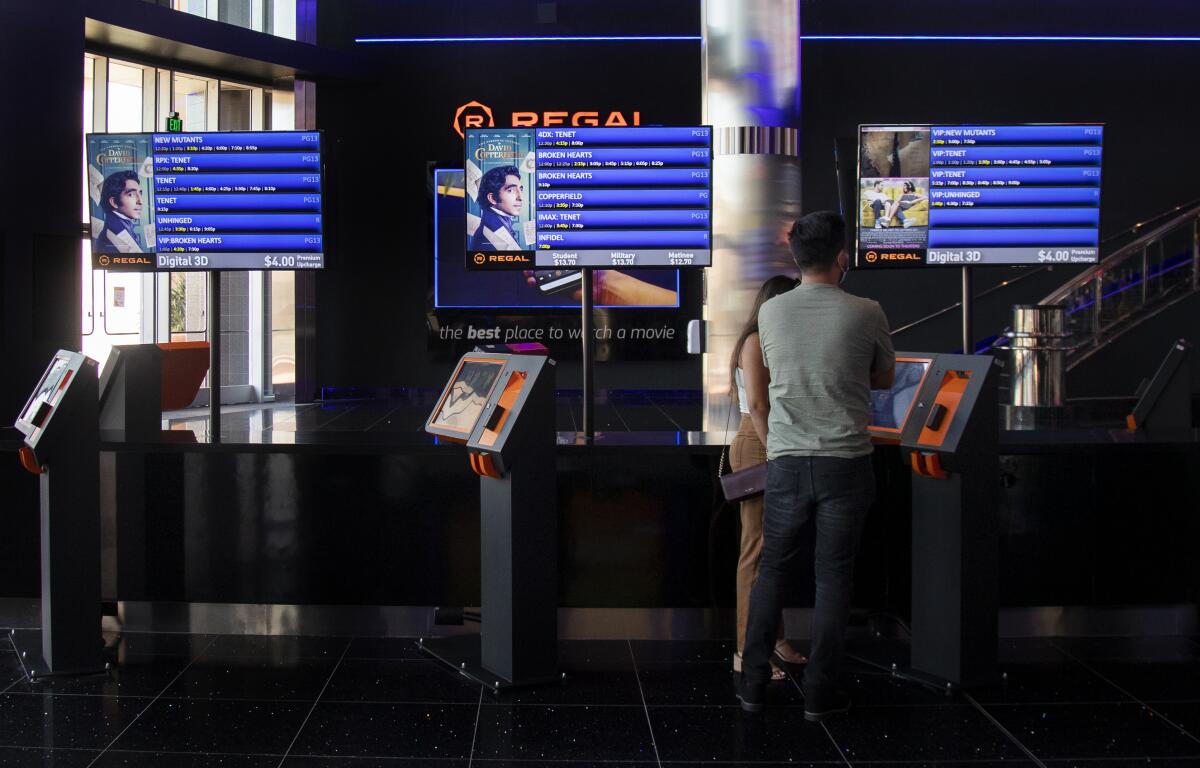California movie theaters are reopening. Will there be any new films to show?

At the sprawling Irvine Spectrum Center, the 21-screen Regal movie theater didn’t hibernate through the pandemic that has wrecked the movie industry for the last six months. It got a multimillion-dollar makeover.
Following a renovation that cost at least $12 million, the theater quietly reopened last week with a new smoothie shop, a craft cocktail bar and a sleek lobby featuring a digital ribbon display to showcase previews for “Tenet” and other movies.
Spending big bucks to remake a movie theater might seem like a counterintuitive move at a time when the film industry faces unprecedented uncertainty. But to Mooky Greidinger, chief executive of Regal’s parent company, Cineworld, the face-lift, which began before the COVID-19 pandemic shuttered theaters, represents a bet on the future of cinema.
“The pandemic is a really crazy situation. We debated a lot internally whether to continue this refurbishment,” said Greidinger, via Zoom from Israel. “We believe this is going to be a great message for our customers that we also did something for them through this difficult time.”
Withstanding months of closures was hard enough for the major theater chains like Regal, the second-largest circuit in the U.S. with 549 theaters and 7,211 screens. Now that cinemas are open again in much of the country, including some parts of California, the big challenge is getting patrons to come back.
As ‘Tenet’ begins its U.S. debut and California inches toward reopening, some moviegoers are less concerned than others about returning to theaters.
Exhibitors are facing a harsh couple of months ahead as Hollywood studios continue to delay their big films after the disappointing U.S. release of Warner Bros.’s Christopher Nolan movie “Tenet,” which grossed $29 million domestically in its first two weeks.
“Wonder Woman 1984,” also from AT&T-owned Warner Bros., last week moved from Oct. 2 to Christmas. Universal Pictures’ horror reboot “Candyman,” pegged for mid-October, was delayed until 2021. STX Films’ Gerard Butler action feature “Greenland” will come out on a to-be-determined date this year. Disney also is contemplating whether to stick with its Nov. 6 release date for its upcoming Marvel Studios film “Black Widow,” according to people familiar with the matter who were not authorized to comment.
“The cupboard is bare. They cleared out everything,” said Jeff Bock, a box office analyst with Exhibitor Relations. “You start to believe in the marathon and then everyone jumps off a cliff right after the start of the race.”
The lack of new movies is a big problem for theaters already hobbled by seating limits of 25% to 50%, lingering fears of the virus among consumers and an ever proliferating number of streaming options. Analysts said some theaters will have to cut operating hours to stem losses. Some might even decide to shut their doors again. “This was the worst-case scenario for theaters,” Bock said.
Some say the studios’ reaction to “Tenet’s” debut was premature. In the run-up to the release, Warner Bros. positioned the film as a “marathon, not a sprint.” Indeed, “Tenet,” a $200-million, time-twisting espionage thriller, did much better business in countries that have gotten the virus relatively under control. Analysts predict it will soon reach the $200-million mark in sales from foreign markets.
In the U.S., though, the release highlighted monumental hurdles for Hollywood. The three biggest markets — Los Angeles, New York and San Francisco — remain largely closed. Those three areas normally account for about 20% of annual domestic box office receipts and are particularly hot markets for Nolan’s headier pictures, such as “Inception.”
“It’s tough to judge this movie on its own,” said B. Riley FBR analyst Eric Wold, who saw the film recently at a Cinemark theater in Austin, Texas. “It’s a 2 1/2-hour, complicated, confusing movie, so it’s not going to appeal to everybody.”
Another problem is that many moviegoers don’t even know cinemas are open, partly because the vast majority of media outlets that cover the industry are based in places that are still shut down. In areas where theaters are open, just 45% of people polled by data firm NRG said they knew that their preferred multiplex had returned. And only about half of moviegoers are actually comfortable returning to theaters as of this week, according to NRG numbers.
That’s even though theaters are open in about 70% of the country, with 35 states clearing all their exhibitors to return, while 12 are bringing cinemas back county by county. Three — New York, New Mexico and North Carolina — remain completely closed. In California, the situation is starting to loosen up, with Orange County reemerging last weekend, and Marin County getting the green light this week.
Hollywood wants to reopen and companies are asking crews to sign liability waivers should an on-set outbreak occur; lawyers say they might not be legal.
Given the confluence of problems, it was always going to take more than a single Nolan blockbuster to spur the industry’s recovery from the pandemic.
“It was never contemplated that one movie was going to carry a whole industry,” said Jeff Goldstein, president of domestic distribution for Warner Bros. “There need to be more movies in the marketplace, and there need to be more markets open. These markets need to be open for the business to be healthy, and these exhibitors are working hard to get the word out there that they’re open.”
The key, exhibitors and analysts said, is getting Los Angeles and New York open so that studios can feel safe releasing their pricier films. New York’s continued reluctance to open theaters has been a particular point of frustration for theater companies, given the relatively low coronavirus cases in the state. It’s unclear when Los Angeles County will move into the reopening tier that will allow theaters to return.
While many films can lean heavily on international markets to bolster their returns, movies including “Wonder Woman 1984” need U.S. cinemas to be open to succeed. The domestic market accounted for more than half the $822 million in worldwide grosses for 2017’s “Wonder Woman,” for example.

“We have an issue, which is a little bit of a chicken or the egg,” Greidinger said. “It’s how many cinemas are open, and do we have California and New York? For the studios to release their big movies without New York and California, even with California partly open, is really very, very difficult.”
As the U.S. struggles, theater owners are looking to international markets for signs of life. China, the world’s second-largest box office market, reopened its massive cinema market in July by limiting auditorium capacity to 30% and has gradually loosened restrictions. Theaters in China are poised to increase seating availability to 75% on Sept. 25.
In a promising sign of the demand for theatrical movies, the Chinese production “The Eight Hundred” has grossed more than $400 million in that country since its launch about a month ago. Disney’s “Mulan” remake, on the other hand, debuted with a tepid $23.2 million in its first weekend in China, but analysts said poor audience reviews, piracy and the lack of local media coverage amid a geopolitical controversy were to blame.
“When people feel it’s safe to come out, they come back to the cinema in droves,” said John Fithian, president of the National Assn. of Theatre Owners. “We’re just a little behind the curve in the U.S.”
Even locally, some theaters demonstrated signs there is pent-up demand for indoor moviegoing, as long as there are new films to see. The Regal Irvine Spectrum was the second-highest grossing theater in the country for “Tenet” last weekend, behind just AMC Orange 30.

Some screenings in the theater’s smallest auditoriums, were sold out, said general manager Jake Pasqualetto during a tour of the facility, though that’s a modest accomplishment for a 50-seat theater limited to a quarter of its seats.
“I was surprised,” said Pasqualetto. “Without much marketing or social media stuff right off the bat, we had pretty high traffic.”
Patrons can’t experience all of the theater’s fancy new accommodations just yet. The seats meant for the VIP lounge area remain roped off. A new video arcade area is also closed.
To ensure proper cleaning in its auditoriums, the theater is increasing the time between its screenings by at least 30 minutes. All over the lobby, there are signs reminding moviegoers to wear masks and stay six feet apart.
“When people come in here, they can see this place is so palatial, they can stay away from everyone so easily, so they all feel comfortable,” Pasqualetto said.
As theaters tout their enhanced cleaning protocols, owners are anxiously waiting for the next batch of films scheduled to come out, including the James Bond movie “No Time to Die” and Pixar’s “Soul,” both scheduled for Nov. 20. In a surprising move, Universal this week moved its DreamWorks Animation sequel “The Croods: A New Age” from Dec. 23 to Nov. 25, putting it in direct competition with the Pixar offering.
Universal declined to comment on the decision.
No one expects theatrical attendance to return to anything close to normal until there’s a widely available vaccine. Until then, studios are expected to continue to experiment with different ways of releasing movies, including through premium video-on-demand, as Universal did with “Trolls World Tour” and Disney did with “Mulan.”
But despite all the delays, Greidinger remains confident that people will return en masse when the pandemic subsides — whenever that happens.
“The pandemic is, in our eyes something [that] is here today and will be gone tomorrow,” he said. “The question is: When is tomorrow?”
More to Read
Inside the business of entertainment
The Wide Shot brings you news, analysis and insights on everything from streaming wars to production — and what it all means for the future.
You may occasionally receive promotional content from the Los Angeles Times.











